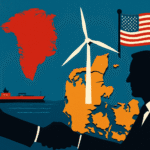In northeastern Germany’s Kieshofer Moor, a swampy expanse of peatland dotted with alder trees and ferns, Dutch biologist Hans Joosten points out an unusual strategic value. Heavy armoured vehicles, he notes, would sink quickly into the marsh. What seems like inhospitable land could, in fact, be a powerful deterrent to invading armies.
Joosten, often referred to as the “peatland pope”, believes restoring Europe’s drained bogs could help defend against two major threats at once: Russian aggression and climate change. Rewetting peatlands, he argues, offers both a natural military barrier and an effective way to store carbon. “There are too many win-win situations to neglect,” he says.
A Long History of Water as Defence
The idea of using water and marshes in military strategy is not new. Prussian strategist Carl von Clausewitz once described bogs as “the strongest lines of defence.” History provides examples from Arminius’ ambush of the Romans in the Teutoburg Forest to the Dutch waterline, where flooding helped the Netherlands repel Spanish and French forces in the 16th and 17th centuries.
Even in modern conflicts, wetlands have proven critical. In 2022, as Russian forces advanced on Kyiv, Ukraine deliberately blew up a dam north of the capital. The resulting floods forced Russian troops to reroute, buying Ukraine vital time to strengthen its defences. Ukrainian experts describe water and swamps as natural anti-tank ditches that remain central to their strategy today.
Mixed Views Across Europe
Some European leaders see wetlands as a valuable defensive asset. Estonia’s Prime Minister Kristen Michal has said natural barriers such as swamps and lakes are being integrated into defence planning.
Others, however, remain cautious. In March, four US soldiers died when their armoured vehicle became trapped in a swamp near Lithuania’s border with Belarus during a training exercise, highlighting the risks to NATO’s own forces. Germany’s defence ministry has also said that refilling wetlands for purely military purposes is “not a priority.”
In Poland, environmentalists note a disconnect between rhetoric and policy. While scientists proposed wetlands as natural defences, Warsaw instead erected a five-metre steel fence through the Białowieża forest to curb migration via Belarus, a move seen as conflicting with environmental protection.
Climate and Environmental Benefits
Beyond defence, peatlands play a crucial role in the global climate system. Peat is formed from partially decomposed plants. When drained, it emits carbon dioxide, accounting for an estimated 5 per cent of global emissions. But when rewetted, peatlands once again act as carbon sinks. Scientists argue that restoring these wetlands is essential to reaching net zero targets by 2050.
Joosten and his colleagues at the Greifswald Moor Centre are researching sustainable uses for rewetted lands, such as cultivating reeds, bulrushes, and peat moss for commercial products. Still, rewetting faces resistance from locals and farmers, who complain about damp homes, insect problems, and reduced grazing land.
A Humanistic Form of Defence
Despite challenges, Joosten insists that only 5–10 per cent of Europe’s rewetting efforts would need to serve defensive purposes. The rest would focus on biodiversity, climate, and water management.
He frames the idea as not only practical but also humane. Unlike traditional weapons, bogs and wetlands “do not shoot back,” he says, yet they can still deter hostile forces. For Joosten, the overlap between ecological restoration and national defence could make peatlands an overlooked but vital asset in Europe’s security strategy.








